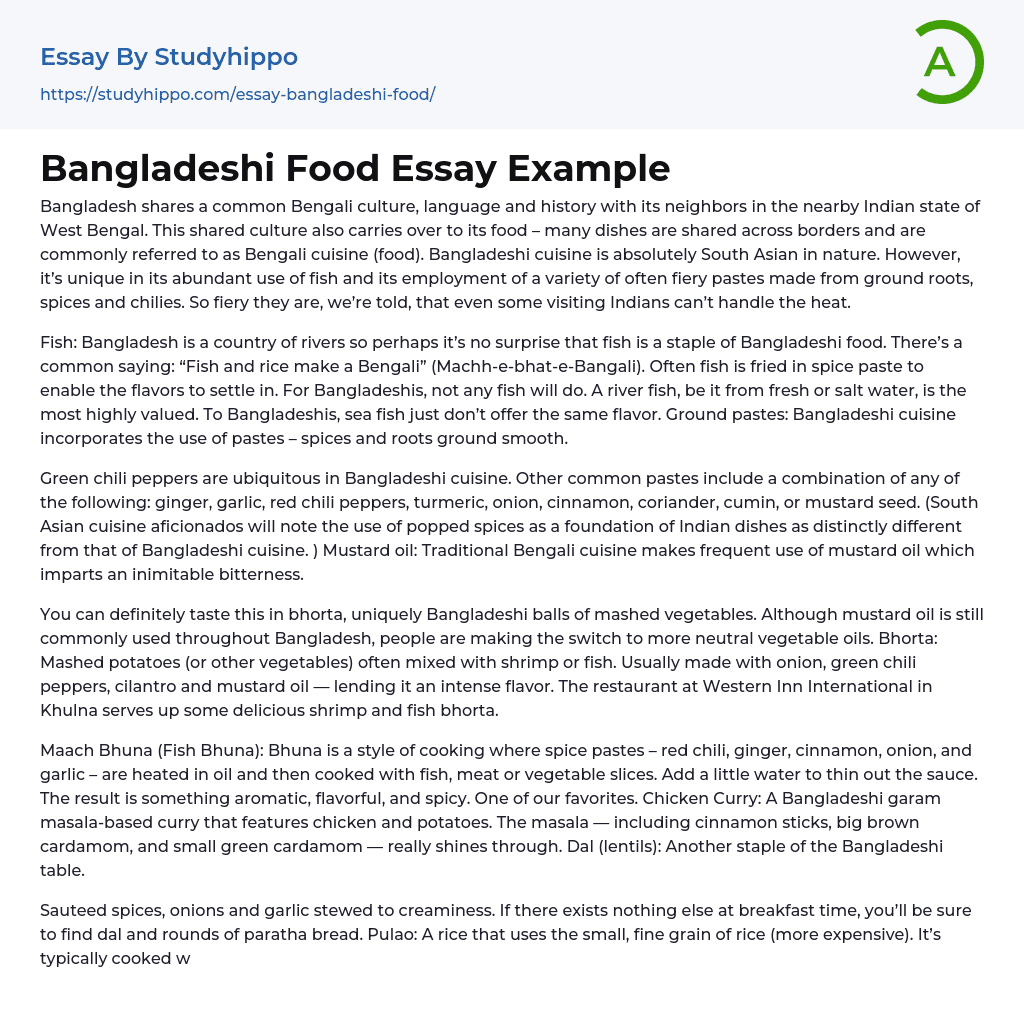Bangladesh shares a common Bengali culture, language and history with its neighbors in the nearby Indian state of West Bengal. This shared culture also carries over to its food – many dishes are shared across borders and are commonly referred to as Bengali cuisine (food). Bangladeshi cuisine is absolutely South Asian in nature. However, it’s unique in its abundant use of fish and its employment of a variety of often fiery pastes made from ground roots, spices and chilies. So fiery they are, we’re told, that even some visiting Indians can’t handle the heat.
Fish: Bangladesh is a country of rivers so perhaps it’s no surprise that fish is a staple of Bangladeshi food. There’s a common saying: “Fish and rice make a Bengali” (Machh-e-bhat-e-Bangali). Often fish is fried in spice paste to enable the flavors to settle in. F
...or Bangladeshis, not any fish will do. A river fish, be it from fresh or salt water, is the most highly valued. To Bangladeshis, sea fish just don’t offer the same flavor. Ground pastes: Bangladeshi cuisine incorporates the use of pastes – spices and roots ground smooth.
Green chili peppers are ubiquitous in Bangladeshi cuisine. Other common pastes include a combination of any of the following: ginger, garlic, red chili peppers, turmeric, onion, cinnamon, coriander, cumin, or mustard seed. (South Asian cuisine aficionados will note the use of popped spices as a foundation of Indian dishes as distinctly different from that of Bangladeshi cuisine. ) Mustard oil: Traditional Bengali cuisine makes frequent use of mustard oil which imparts an inimitable bitterness.
You can definitely taste this in bhorta, uniquely Bangladeshi ball
of mashed vegetables. Although mustard oil is still commonly used throughout Bangladesh, people are making the switch to more neutral vegetable oils. Bhorta: Mashed potatoes (or other vegetables) often mixed with shrimp or fish. Usually made with onion, green chili peppers, cilantro and mustard oil — lending it an intense flavor. The restaurant at Western Inn International in Khulna serves up some delicious shrimp and fish bhorta.
Maach Bhuna (Fish Bhuna): Bhuna is a style of cooking where spice pastes – red chili, ginger, cinnamon, onion, and garlic – are heated in oil and then cooked with fish, meat or vegetable slices. Add a little water to thin out the sauce. The result is something aromatic, flavorful, and spicy. One of our favorites. Chicken Curry: A Bangladeshi garam masala-based curry that features chicken and potatoes. The masala — including cinnamon sticks, big brown cardamom, and small green cardamom — really shines through. Dal (lentils): Another staple of the Bangladeshi table.
Sauteed spices, onions and garlic stewed to creaminess. If there exists nothing else at breakfast time, you’ll be sure to find dal and rounds of paratha bread. Pulao: A rice that uses the small, fine grain of rice (more expensive). It’s typically cooked with bay leaf, cinnamon sticks and topped with crispy dried onion. Delicious. You know you are considered someone special when the finer grained pulao comes out. Biryani: Spiced rice served with some sort of meat or chicken, sometimes mixed in and other times served on top of the rice.
Maybe we just chose poorly, but we never really had a great biryani meal during our trip. Egg curry: Hard
boiled eggs served up in a creamy curry sauce looked a bit odd to us at first, but the taste: remarkably good. Served with crispy onions on top. Singara: Much like samosas, singara (the round items above) are spiced potato and vegetable mixture pockets wrapped in a thin dough and fried. What distinguishes a good singara is the flaky texture, almost as if it’s made with savory pie crust.
Singara are really tasty and inexpensive snack (as cheap as 24 for $1) that you can find almost anywhere in Bangladesh. Samosa: In India, samosas are usually stuffed with potatoes and spices. Bangladeshi samosas tend to be triangular, filled with cabbage and other vegetables, and are more heavily fried and crunchier than either singara or their Indian samosa cousins. Paratha: A thin fried flat bread that can be found everywhere throughout the country. Most often eaten at breakfast.
- Food essays
- Genetically Modified Organisms essays
- Child Development essays
- Eating essays
- Breakfast essays
- Genetically Modified Food essays
- Milk essays
- Chewing gum essays
- Energy Drink essays
- Caffeine essays
- Chocolate essays
- vegetarian essays
- Weight Loss essays
- Anorexia essays
- Metabolism essays
- Diet essays
- Vitamin essays
- Dieting essays
- Junk Food essays
- Eating Habits essays
- Food Safety essays
- Food Security essays
- Beverages essays
- Cuisines essays
- Dairy essays
- Desserts essays
- Fast Food essays
- Bread essays
- Meal essays
- Meat essays
- Organic Food essays
- Rice essays
- Sugar essays
- Taste essays
- Beef essays
- Coconut essays
- Crowd essays
- Dinner essays
- Juice essays
- Sainsbury essays
- Cooking essays
- Ginger essays
- Oreo essays
- Drink essays
- Beer essays
- Wine essays
- Coffee essays
- Tea essays
- Cake essays
- Hamburger essays




